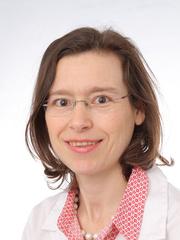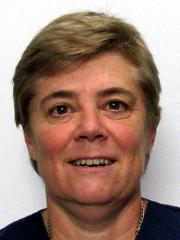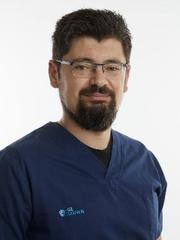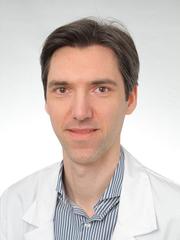Purpose of the study
Polysomnography literally means “the recording of many signals during sleep”. It is a complex test that we only perform when necessary. The analysed data help the doctor diagnose a sleep or wakefulness disorder.
The goal is to examine:
- when and how long you sleep;
- how deep your sleep is and whether you have REM sleep;
- how you breathe during sleep;
- your movements during sleep;
- your heart rate during sleep.
Preparing for the study
Personal hygiene
- Wash your hair beforehand. Do not use any conditioner, gel or hairspray afterwards.
- Men should shave their face thoroughly. A long beard can remain, but stubble prevents placing sensors on the chin.
- Remove all make-up and creams so they do not interfere with the application of electrodes.
- Do not wear jewellery.
- The index fingers may not bear any nail polish or artificial nails.
What should you bring?
- Your identity card for registration
- The referral letter (if referred by an external doctor)
- A close-fitting T-shirt and pyjama trousers or shorts (preferably not a full pyjama set or nightgown). The equipment wires and straps are placed over this clothing. Sleeping naked is not allowed.
- Comfortable clothing with buttons or a zip to wear over the T-shirt and pyjama trousers or shorts when leaving the ward.
- Toiletries, towels and flannels.
- Shampoo, possibly conditioner, and a comb to remove any glue residue from your hair.
- Shaving equipment if needed
- Your home medication (enough for the entire stay)
- Your own pillow and blanket if that helps you sleep better.
- Forms for your hospitalisation insurance (if applicable)
Polysomnography for titration or follow-up of your CPAP treatment or home ventilation
If the sleep study is for titration or monitoring of your CPAP treatment for sleep apnoea or of your home ventilation (even without CPAP), please also bring your CPAP device or your ventilation or cough augmentation device with all necessary accessories.
Your stay
Your room
- The sleep study takes place in a single room with a private bathroom including toilet, sink and shower.
- You can use the Octopuz screen next to your bed to make phone calls and watch television.
- There is free wifi in the hospital, so you may also bring your own laptop, tablet, or smartphone.
- You will have a personal locker with a key to store valuables if you leave the room. Please bring as few valuables as possible.
Use of multimedia
You may use a laptop, tablet, or smartphone via the free wifi. These devices may not be connected to a mobile network (3G, 4G, 5G) in the ward to avoid interference with monitoring equipment.
You can make phone calls using the device in your room.
When you go to sleep and the lights in the room are turned off, the laptop, tablet, smartphone and all other multimedia must be completely switched off. The phone will also be deactivated. In urgent cases, you can be reached through the nurses (tel. 016 34 25 20).
When do you come to the hospital?
You will arrive at the hospital in the afternoon, as several people are tested each night.
- The nurse-sleep technologist will place all the sensors. The equipment is set up and tested correctly.
- You may be asked to complete a few additional questionnaires.
- Dinner will be served in your room.
- You may move around freely until 20:00; the equipment is semi-portable. After that, the final connections are made and you must remain in bed.
When do you go to sleep?
- You may go to sleep at your usual time, but no later than midnight. You call the nurse-sleep technologist when you are ready.
- The nurse-sleep technologist will turn off the lights and start the monitoring.
- The study must legally last at least 8 hours. This means that the sensors will only be removed at the earliest 8 hours after lights-out.
- You may not use an alarm clock or ask us to wake you at a specific time. You are therefore required to sleep in, as the last hour of your natural sleep is also important for the test.
What measurements are taken?
- EEG (electroencephalogram): electrodes on your head measure brain waves and help determine whether you are asleep, how deeply, and whether you experience REM sleep.
- EOG (electro-oculogram): electrodes next to your eyes record eye movements and help assess sleep depth and REM sleep.
- EMG (electromyography): electrodes on your chin measure muscle tension and help assess sleep depth and REM sleep.
- ECG (electrocardiogram): electrodes on your chest measure the rhythm and rate of your heartbeat.
- Airflow: a sensor at your nose and/or mouth monitors whether you are breathing.
- Breathing movements: elastic bands around your chest and abdomen track your breathing motion.
- Blood oxygen: a special electrode on your finger measures blood oxygen levels and records your pulse.
- Snoring: a sensitive microphone taped to the skin at your windpipe, a decibel meter beside the bed, and the camera microphones record snoring.
- Leg movements: sensors on each ankle record your leg movements.
- Video: your sleep is filmed using a video camera with sound. These recordings may help establish an accurate diagnosis. For privacy reasons, they can only be viewed by the centre’s staff and are completely deleted after the test. Only clinically relevant clips may be kept in your patient file.
- Carbon dioxide in the blood (optional): for some patients, a sensor on the earlobe or forehead measures the carbon dioxide level in the blood. This is an important indicator of breathing quality. Read more about this test (transcutaneous capnography).
Can you sleep with all these sensors?
-
Yes, most people sleep well. The electrodes are placed in a way that does not interfere with turning or moving during sleep. They are attached using glue or adhesive tape and this is painless. This is done several hours before the start of the study so that you are already used to them by the time you go to sleep.
What if you need to go to the toilet?
-
You call the nurse-sleep technologist, who will disconnect the necessary sensors so you can go to the toilet as usual.
After the study
After you wake up, the nurse-sleep technologist will remove all the electrodes. The glue will be removed with a special solvent. You will then shower and wash your hair to remove any remaining glue and solvent.
Many patients wake up around the same time, so you may have to wait a little.
Discharge from the hospital
The procedure for your discharge depends on the specific purpose of the study.
After a polysomnography for the diagnosis of a sleep disorder
- Breakfast is provided if you wish.
- If no further tests are scheduled, you may go home.
- In practice, it is usually well after 08:00 before you can leave. Please take this into account when planning your day.
After a polysomnography for the titration or control of your CPAP treatment for sleep apnoea
- The polysomnography is analysed in the morning. Based on this, we determine a personalised treatment pressure for your CPAP device.
- In the meantime, you will receive guidance on how to use and maintain the device and its accessories.
- Once the pressure has been determined, the doctor will discuss the treatment with you.
- You may then go home. This will happen no later than 13:00.
- Breakfast and lunch are provided.
After a polysomnography for the titration of your home ventilation
- You will stay at the sleep centre for several days. We generally plan four days and three nights, but this may be shorter if titration goes smoothly.
- The day and time of discharge cannot be determined in advance and will be clarified during your stay.
After a polysomnography for the control of your home ventilation
- The polysomnography is analysed in the morning to assess the effectiveness of your treatment.
- The doctor will then discuss this with you and, if necessary, make adjustments to the treatment.
- You may then go home. This will happen no later than 14:00.
- Breakfast and lunch are provided.
Results
During the study, many signals are recorded as waveforms. These are carefully reviewed and analysed by the sleep technologists and doctors. This takes time. The morning after your stay, we are therefore unable to provide you with results.
It may take up to four weeks or longer for the results to be available. These will then be sent as soon as possible to your referring doctor or GP.
Upon admission, we will check who should receive the results and whether an appointment has already been scheduled. Results are never communicated by phone.
Specialists



